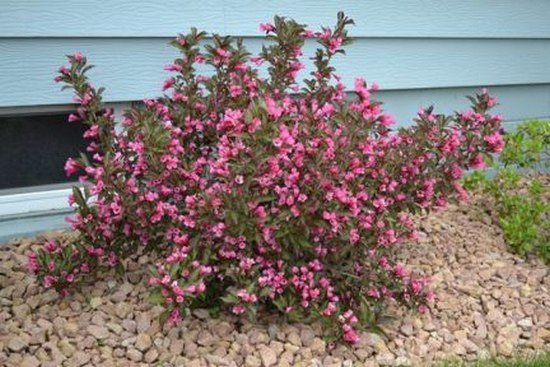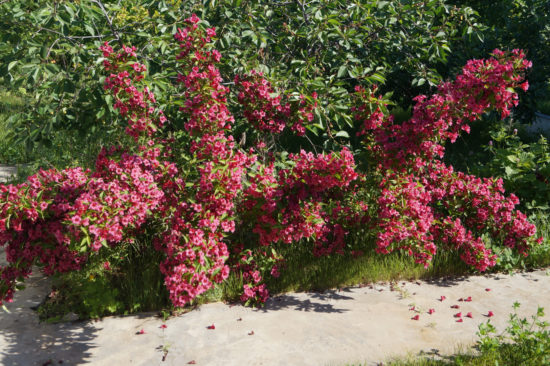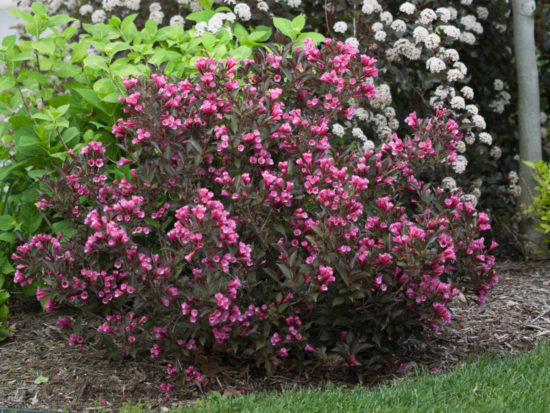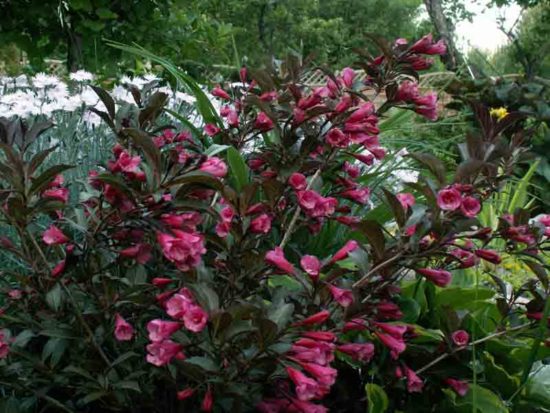Weigela dwarf varieties
Tango
|
The dwarf variety is valued for its resistance to frost and to growing in places with high gas pollution, for the beauty of flowers and leaves, for strong immunity and endurance. |
- Prefers sunny drained areas with uniformly moist soil of neutral or slightly acidic reaction, does not grow on saline soils.
- Well-developed roots are at a shallow depth.
- At the age of ten, the width of the crown and the height of the bush reaches one hundred centimeters, for a year the growth is equal to twenty centimeters.
- The length of the leaves is about six centimeters, the color changes during the season and can be reddish, copper, purple, green, brown and bronze.
- Blooms in June and July, racemose inflorescences are collected from five to six pink or burgundy flowers with a diameter of about three centimeters.
- Frost resistance: -25 (zone 5) is not hardy enough for the middle zone, but winter hardiness increases with age.
Black and White
|
A slow-growing, undersized variety of weigela, up to eighty centimeters high, loves moderately moist areas with a lot of sunlight and heat. |
- Dark green foliage and numerous white flowers, similar in shape to bells, look harmoniously together.
- Used for solo and group landings, protection from strong gusts of wind is required.
- Winter hardiness is good (zone 4), but it is better to winter with shelter
Eva Rathke
|
A hybrid variety of Polish origin, it has a spreading crown and is distinguished by long flowering - throughout the summer months. |
- The average height is about 100 - 120 centimeters, the width of the crown is about 150 - 200 centimeters.
- The leaves are bright green, oval in shape, eight to ten centimeters long.
- The flowers are fragrant, bell-shaped, red or pink.
- Life expectancy is about fifty years.
- It grows in cold climates with temperatures dropping in winter to 26 degrees below zero. In more severe frosts, shelter is required, since the ends of the branches often freeze slightly.
Victoria
|
Compact plants are recommended for landscaping a small front garden or mini garden. With a small growth, the bush has a massive spherical dense crown. The growth of the bush per season is no more than fifteen centimeters. |
- The leaves in partial shade are red-brown in color, in the open sun they are completely brown, the length is about twelve centimeters.
- Funnel-shaped inflorescences with a heady aroma consist of several flowers - a dark pink shade on the outside and lighter on the inside.
- The root part is close to the soil surface.
- The level of frost resistance is quite high, plants can be without shelter at 35 degrees below zero.
Victoria is popular in many regions, but especially in the central part of Russia.
Naomi Campbell
|
A dense winter-hardy shrub requires attention in the form of moderate watering, regular feeding and sanitary pruning. Loves areas with moderate humidity, with slightly acidic soil and a sufficient amount of nutrients. |
- With a bush height of about eighty centimeters, the crown grows up to 120 centimeters wide.
- Differs in the darkest leaves among many other varieties of weigela. They are painted in dark shades of red, brown and bronze.
- The diameter of the purple-red flowers is three to four centimeters. Blooms in the first half of the summer season.
- Full solar lighting required. In the shade, the leaves turn green, and flowering does not occur.
- Frost resistance is not high enough (zone 5) up to -25º
Don't forget to read:
- What varieties of spirea to plant on the site
- Forsythia shrub - the best varieties and rules of care
- Choosing the best varieties of deren
- Japanese quince - planting and care, photo
How to take care of it properly?
Proper care of the plant involves the implementation of all agrotechnical rules.
- Watering. The plant should be watered regularly, not allowing the soil to dry out. Dry soil at a depth of 2 cm indicates the need to moisten it. Weeds should also be removed when watering.
- Loosening is carried out simultaneously with watering. The earth is loosened and shallow (8-10 cm), since the weigela has a superficial root system, it can be damaged.
- Mulching the soil under the bush helps retain moisture and prevents weed growth.
- Top dressing. When growing a shrub, top dressing is done three times a season. The first is applied before the onset of the growing season and mineral fertilizers (superphosphate, urea) are used, which are placed under the bush before the snow melts. The second is introduced in the bud formation phase. At this time, fertilizers containing potassium are used. The third should be done at the end of summer to prepare the weigela for wintering. It is possible to use ash or the preparation "Kemira-autumn". If compost or other organic matter was additionally introduced into the pit during planting, then feeding the bush begins only from the age of 3.
- Pruning. It is done 2 times. The first sanitary is carried out in the spring and all damaged, frostbitten or with signs of disease are removed. The second is carried out immediately after the end of flowering. At the same time, shoots with dried flowers are cut off.
- Preparing for winter. In regions with very cold climates, it is necessary to cover the plant for the winter. The bush is insulated with a covering material, and the soil around it is covered with foliage, spruce branches. In the spring, after the snow melts, the shelter is removed.
Growing rules
Moisture-loving weigel Solar Princess needs to be provided with regular moisture and loosening of the soil.
Watering
Weigela needs abundant watering - no less than a bucket of water per week in spring, before flowering and in hot summer. It is better to water with a large volume, but so that moisture reaches all the roots.
Top dressing
In the spring, it is convenient to feed the weigela with any complex fertilizers with three main microelements. They also use preparations for flowering shrubs. The granules are scattered around the perimeter of the trunk circle or diluted in water, according to the manufacturer's recommendations. After fertilization, the weigelu is watered abundantly. Weigel is given the same top dressing at the end of spring, during the period of bud formation. Phosphorus-potassium agents are applied in August.
Loosening, mulching
After watering, the weigels loosen the ground 6-8 cm deep. Mulching will ensure the soil is breathable in all weather conditions. Peat, bark, sawdust, dry grass without seeds are used as raw materials.
Pruning, crown shaping
A lush bush of weigela blooming Sunny Princesses, as in the photo, is created by constant annual pruning:
- sanitary cleaning and correction of the shape of the plant is carried out in early spring by removing damaged, thickening or protruding shoots;
- in July, after the first wave of flowering, the old shoots of the weigel are cut off by a third;
- when pruning, a point is chosen where a large external kidney or a young process is laid;
- separate young powerful branches are cut in half, forming a lush bush;
- after 2-3 years, rejuvenating pruning of old branches is carried out at ground level.
Preparing for winter
The variegated variety of weigela Sunny Princess is moderately winter-hardy. In late autumn, a thick layer of mulch is laid. The plant is covered for the winter with agrofibre or mats made of natural materials, bending branches or arranging a high frame. The shelter is not removed in early spring, only raising the edge for airing.Weigela branches after frost are best shaded from bright rays.
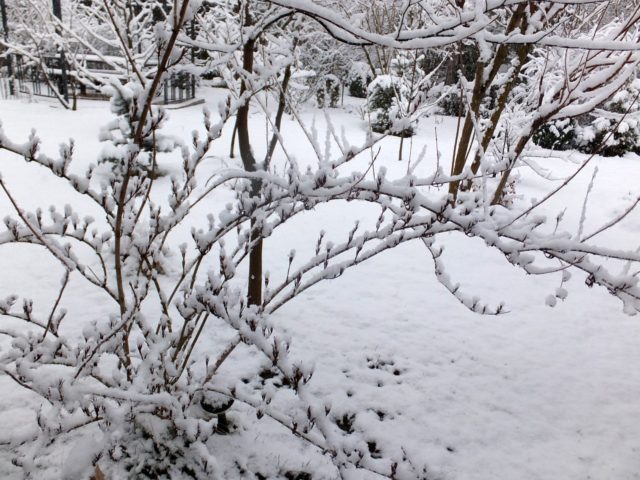
1.Description - how it looks
Weigela is a deciduous flowering shrub that can be safely grown both as a flowering plant and as an ornamental plant. Bushes have profusely branched erect or drooping shoots covered with smooth brown or burgundy bark.
Leaves 5 to 20 cm long are green, lanceolate, with pronounced branched leaf veins. There are small denticles along the edge of the leaf plates. The leaves are arranged in opposite pairs, on short petioles. In variegated varieties, the color of the leaves can include all shades of green in combination with yellowish and white stripes along the edge of the leaf.

The flowers are tubular, with 5 petals fused at the base, red, pink, yellow or white, reaching a diameter of 4 - 5 cm.In some varieties, the color of the buds can change as it blooms - from white to pink and red - thus on one and the same specimen may contain flowers of different shades.
After flowering, the plants form small seed pods with small, oblong, light brown seeds. Only 15 species of deciduous plants emerge in the genus, only 7 species are used in floriculture.
The name of this plant was given in honor of the German scientist - professor of botany and chemistry, doctor of medical sciences Christian Weigel.
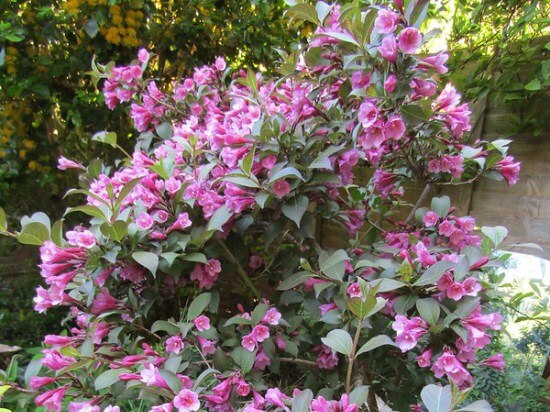
Height. Plant sizes are highly variable depending on the species and can range from 60 cm to 2 - 3 meters. Weigela develops very quickly.
Peculiarities
Spirea "Little princesses" is a dwarf bush that has a spherical shape. Little Princess or "little princess" got its name from its small size compared to other types of spirea. The height of the shrub is only 60 cm, it is extremely rare to find a spirea of this species up to 1.2 m high. During the season, the shrub grows by 10-15 cm, especially rapid growth rates in the first years of life. This shrub belongs to long-livers - it pleases with its beautiful appearance for 25-30 years.
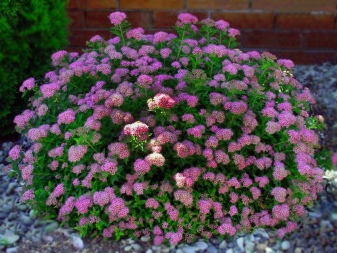

During flowering, the leaves of the spirea acquire an emerald green hue, and in the fall they become orange-red. Flowers bloom in June and bloom until September, with new flowers being formed throughout this period. Japanese spirea is covered with numerous small purple-pink flowers, collected in corymbose inflorescences. The buds are very small and are located at the ends of the branches.
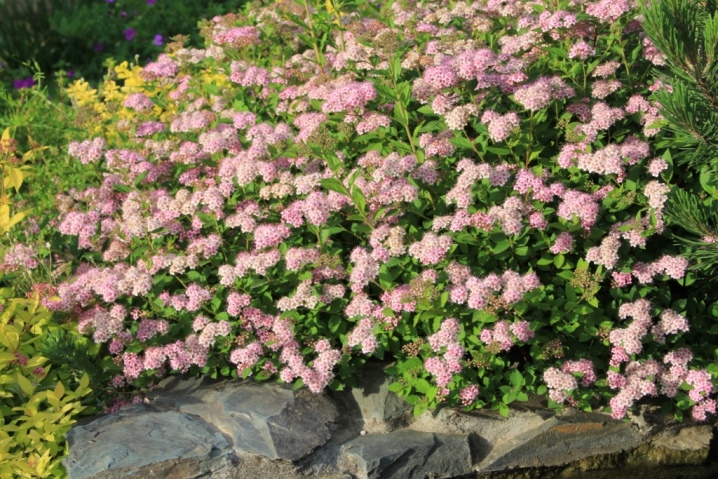
The first flowering begins from the second or third year of the plant's life.
Description of this type of spirea:
- has a spherical lush crown, which can spread up to 1.2 m wide;
- deciduous shrub from the Rosaceae family;
- abundant flowering begins from the third year of life;
- the fruits of spirea look ugly, and they are not eaten, therefore, they are of no value.

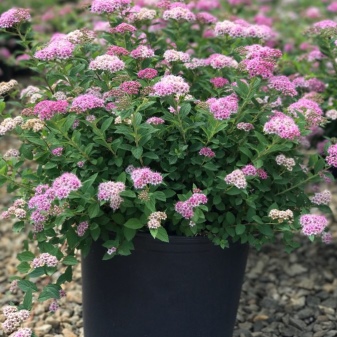
Application in landscape design
The Cossack juniper is considered the most suitable variety of conifers to protect the soil and create beauty in the garden. With its help, it turns out to decorate any object, for example, a staircase or decorate an entrance group to a garden.
In this case, it is not so important whether the surface will be flat or inclined.
Landscape designers very often use Cossack juniper in the design of alpine slides, due to which the difference of different heights is emphasized and played out, the multi-level effect is enhanced and continuous coverings are masked. In principle, the Cossack juniper looks good both in a single version and in group plantings. The coniferous representative can be grown next to evergreens or in the company of deciduous bushes and trees, which looks most impressive.
From the point of view of landscape design, there are no stylistic restrictions on the use of Cossack juniper.It is good both in a natural setting and in a different form. Most often, Cossack juniper is used to design certain zones of the garden plot, thereby pursuing the goals conceived by the designer. In simple terms, in the art of correctly creating a landscape, coniferous plantings are used to decorate and frame several elements of a blooming territory.
- Dwarf seedlings are used to transform the curb line.
- For adding variety to flower beds. When designing artificial reservoirs.
- As an artificial fence for front gardens.
- To decorate the edge of the garden area.
- As an alternative to ground covers in continuous areas and in massifs.
- As decorative elements of small architectural structures.
- High varieties of juniper are used to decorate the further part of the general plan of the ornamental garden.
- The spreading branches of the bush can serve as an ideal decoration for the surface of a mown lawn.
It is important to remember that Cossack juniper is one of the best representatives of phytoncidal plant species. It has health-improving properties, purifies the surrounding air, improves the ecology of a particular area.
As already mentioned, the juniper easily tolerates the procedure of cutting and cutting, which is what landscape designers use when decorating garden plots.
They use niwaki, the art of shearing plants, to give conifers a graceful shape that matches a landscape designer's idea. At the same time, nivaks are mainly used in large areas of garden plots, where you can turn around and turn ordinary plantings into a piece of paradise. In gardens with a small area, juniper bushes are only slightly pruned so that branches do not crawl out onto the path and do not interfere with the growth of other plants.
For information on how to propagate and care for the Cossack juniper, see the next video.
Weigela in landscape design, photo
The flowering weigela shrub cannot be considered a completely unpretentious plant. She has individual requirements for the planting site, soil quality, top dressing. She will feel comfortable in sunny areas, surrounded by lower plants or the same shrubs. Weigela does not like drafts and too windy places; the area on the south side of your house is perfect for her. The soil prefers light and fertile, saturated with humus, moisture stagnation is contraindicated for it. Loams and sandy loams with low or neutral pH levels are the optimal environment for good growth and flowering of the plant. Weigela shrub prefers thorough watering when it is hot summer, the soil should be moistened more often, since with a lack of moisture it will not give color.
This plant has long been used by Chinese and Japanese flower growers to decorate gardens. The height of cultivated varieties varies from 60 cm to 2 m in height, in the wild, shrubs can grow up to 2.5-3 meters
This representative is best suited for the design of hedges, paths, group plantings (also mixed) or solitary plantings that attract attention. It can be an excellent addition to alpine slides, looks great on the slopes, is beneficial and harmoniously combined with various conifers, natural or decorative stones
Weigela in landscape design, photo:
In other words, this plant will look appropriate everywhere. You can plant it near the gazebo or decorate the main entrance (entrance) to the territory, bring bright colors to the background of the site, or make the main emphasis on the front position.
Reproduction methods
Weigela can be propagated by seeds, cuttings and layering.
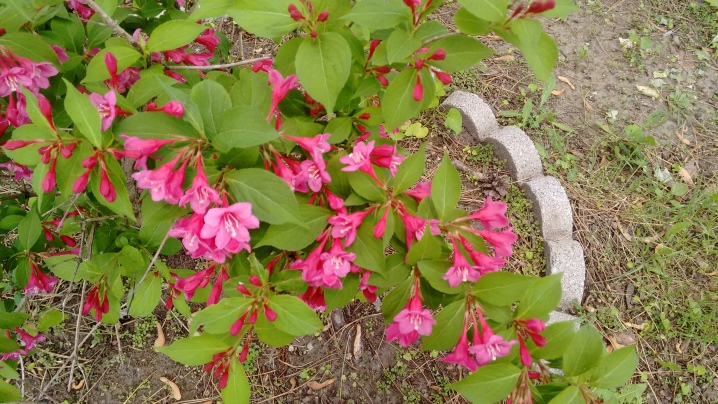
Cuttings
It is possible to grow a shrub that has retained all its maternal qualities by cuttings. It can be done 2 times a season: before the buds open (in March) and in early June. In spring it is done like this.
- Woody twigs are cut off and divided into cuttings, their length is from 10 to 15 cm. Each stalk must have at least 2 buds.
- The leaves are removed from the bottom of the cutting, and the upper ones are cut off to half the length.
- The cuttings are placed for a few minutes in a root growth stimulator (Kornevin, Epin).
- Then they are planted in a container with a substrate consisting of turf soil and sand, taken in equal quantities, deepening by about 0.5-1 cm, and then covered with a film.
- Caring for seedlings consists of regular watering, feeding and daily airing.
- Pinching is carried out on a seedling that has reached a height of 5 cm.

Over the summer, seedlings usually grow up to 25 cm. They need to be transplanted into a separate container and grown at home a year until next fall. During this time, a young bush grows up to 4 shoots. Such a seedling must be transplanted into open soil. In summer, cuttings of green twigs are used. They are prepared for planting in the same way as for spring cuttings. However, the planting of green cuttings is done directly in the ground. They should be covered with a jar, which is removed every day for airing. Watering is carried out daily.
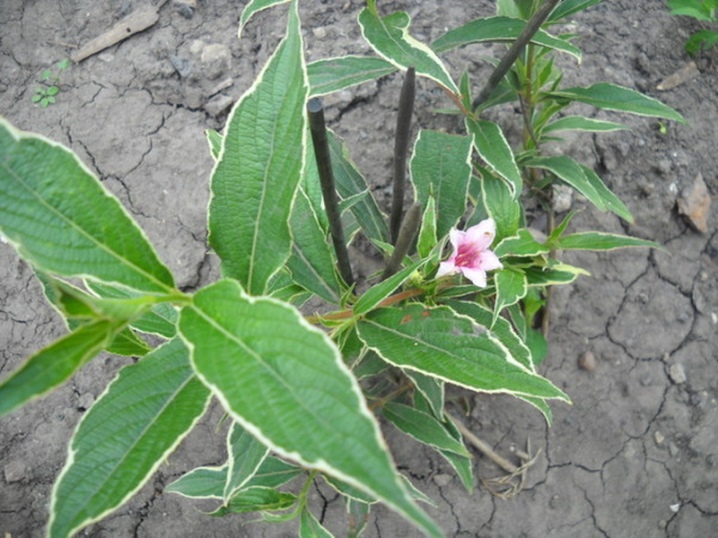
Layers
For layering, choose a healthy, strong lower branch and tilt it towards the soil. In those places where the shoot touches the ground, you need to make an incision in the bark. The branch is attached to the ground and covered with soil. In spring, the layering gives roots and shoots. They can be transplanted to a permanent place only at the age of 3.
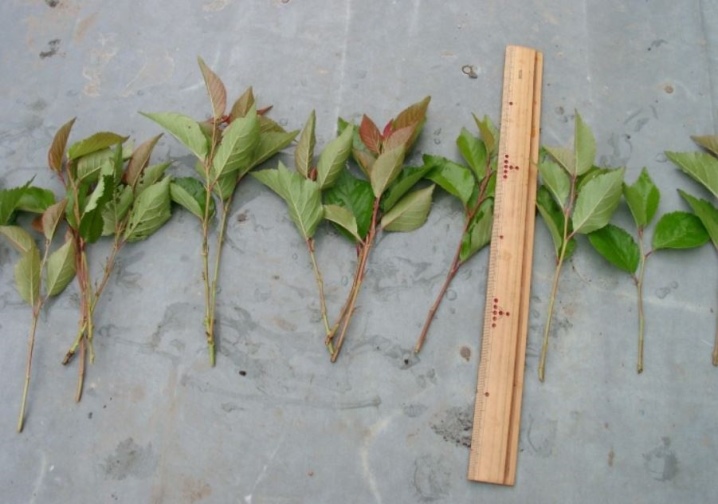
Seeds
With the seed method, the so-called self-seeding is usually used: seeds that have fallen into the ground in the spring can germinate. Of these, the strongest are chosen and the houses are grown for 2 years and only then are they planted in a permanent place.
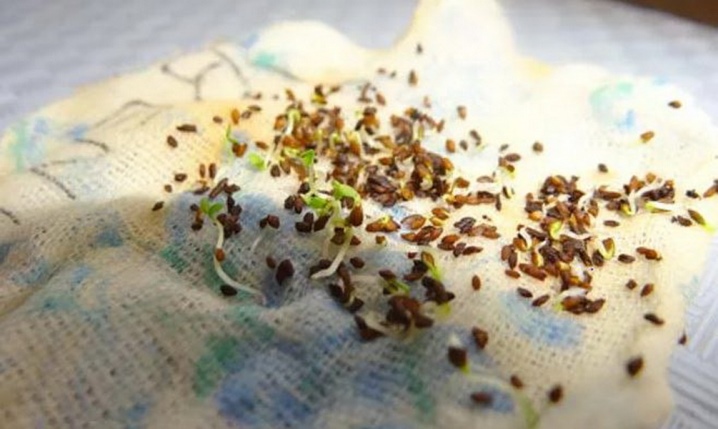
Growing features
Caring for weigela varieties "Alexandra" includes a number of activities.
Water the plant in a timely manner in small portions, the recommended amount is 8 liters of water per bush. If there was little snow in winter, then the watering procedure is carried out immediately after it melts.
Several times a year, this representative of the flora needs fertilization. In early spring, gardeners recommend feeding weigela with a mineral mixture including superphosphate, urea, potassium. During the period of bud formation, potassium and double superphosphate are suitable as additional nutrition. Periodically, you can offer organic culture to the culture, it has a beneficial effect on the development of the shrub.
In the spring, sanitary pruning is carried out, removing dry, injured, frozen branches. To rejuvenate the bush, you can cut off the stems after flowering, the age of which has exceeded 3 years
The formation of a crown for an aesthetic purpose is also allowed.
Before wintering, it is important to properly insulate the plant. It is customary to tie the branches with a rope and bend them to the ground, and cover them with dry foliage or cover them with agrofibre
Under the snow, the specimen will not freeze and will feel quite comfortable, so you can sprinkle shrubs with snow in winter. The plant needs special insulation in the first year of life.
Weigela, reproduction in different ways
The most effective propagation method for this ornamental shrub is cuttings, and for these purposes it is best to use green cuttings. All other methods are ineffective from a practical point of view. The seed method is too labor-intensive, while it is not always possible to preserve the specific features of a single variety. Wood cuttings are a long process and rarely complete successfully, but vegetative propagation with green cuttings is the best option.
How to propagate weigela? You need to choose a time when the process of laying the buds has not yet begun (this is approximately April-early May). The cuttings should have a couple of leaves, the acceptable length should be 10-15 cm, the cut should be even. The leaves can be cut in half, it is recommended to treat the cut with a drug that stimulates growth ("Kornevin", "Heteroauxin").You can leave the cuttings in a preparation diluted with water (for about 10 hours), and then place them in a sand-peat mixture, deepening by a centimeter and a half.
Cover each seedling with a transparent plastic cup or glass jar, such "greenhouses" should be ventilated every day. You also need to water the cuttings daily, in moderation, if shoots appear on the cuttings, pinch them off. If you did everything correctly, then after about 25-35 days, weigela takes root, reproduction by cuttings involves replanting the bushes to a permanent place of residence after at least a year and a half.
The method of propagation by layering, I think, is also worth mentioning. To do this, choose one shoot located at the very bottom of the bush. The place where it touches the ground needs to be slightly injured (cut and slightly bend the bark). Using a wire pin (or other handy tool), you need to attach the shoot to the soil and fill it with it. With the arrival of a new spring, a young seedling will be in this place.
Features and Description
Weigela belongs to the genus of deciduous shrubs of the Honeysuckle family. The area of its growth in nature is represented by the eastern, southeastern Asian regions, the island of Java and the Russian Far East, where you can find 3 types of shrubs. Weigela flowering or florida is one of the species of this plant. This hygrophilous perennial upright shrub of small size does not have a main trunk. An adult bush usually does not exceed 1.5 m, but depending on the variety, the height can vary from 1 to 3 m.

Elongated pointed leaves have serrate or serrate-toothed edges and are opposite. The usual color of the leaves is green or with a reddish tint. However, some varieties of weigela florida may have a different crown color. The inflorescences are bell-shaped or funnel-shaped and are rather large in size. Their color is distinguished by a large abundance of tones: from fawn and white to pale pink and red. Flowers can be arranged singly or in a group, forming small inflorescences.
Care rules
It is necessary to care for the weigela during the growing season, paying special attention to the shrub in the first year after planting
Watering
The frequency and amount of watering depends on the weather. In a dry period, it is recommended to pour up to 10-15 liters of water under the plant. After the procedure, it is necessary to loosen the soil in order to exclude the formation of large lumps of soil that interfere with the flow of oxygen to the root system. You should also spray the leaves periodically to remove dust and other traces of dirt.
Top dressing
In the first two years after planting, the weigela is not fertilized. In subsequent seasons, it is recommended to make:
- potash, phosphorus and nitrogen fertilizers (in spring);
- phosphorus-potassium fertilizers (during the period of bud formation);
- wood ash, Fertik or Kemiru (in early autumn).
In addition to regularly applying top dressing, it is necessary to remove small weeds around the shrub.
Preparing for winter
Weigela tolerates cold well. If the shrub is planted in the southern regions of Russia, then before the beginning of winter it is enough to mulch the soil around the plant. When grown in northern latitudes, the lower branches must be bent to the ground. If there is little snowfall in winter, then the culture needs to provide additional shelter.
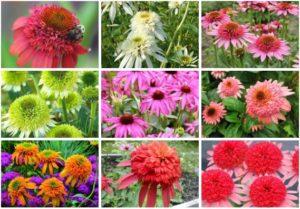
Pruning
Weigels are pruned at different periods. For the prevention of diseases, it is necessary at the beginning of the period of bud swelling and a month before the onset of cold weather to remove damaged branches, as well as shoots that bend to the ground or grow inside the bush.
Mulching
Mulching is carried out twice in autumn and spring and once in summer. For this, peat or sawdust is used. With sufficient mulch application, there is no need for weeding and preparation for winter.
Transfer to another location
Transplanting the plant to a new location is not recommended.But if this cannot be avoided, then the procedure should be carried out in the spring, before the beginning of the growing season. To transplant a bush, it is necessary to dig in the plant, focusing on the length of the crown, and, together with the ground, transfer it to a new place. Then you will need to add 30 grams of complex fertilizer to the prepared hole and deepen the bush. At the end of the procedure, the root system must be sprinkled with soil, watered and mulched.
How to plant?
In order for your green "pet" to feel good throughout all four seasons and to please the eye with a stormy red bloom 2 times a year, you first need to take care of planting it. The bush itself is quite unpretentious, but in order for the planting to be successful, you must adhere to a few simple recommendations.
- Timing of boarding. This process should be dealt with in April or early May, when the soil warmed up under the sun to approximately + 6C °. In autumn, planting can only be carried out in the southern regions, and in the middle lane the plant will not have time to take root.
- Choosing a place. The future shrub house should be quite sunny, so the area is chosen open. An ideal area would be shaded for several hours. And you also need to take into account the fact that the Red Prince hybrid does not like drafts, so you can choose a place not far from any plants that are higher and spreading out of this hybrid.
- The choice of soil. Ideally, it should be loamy, light, fertile and oxygenated soil. Heavy swampy soil will not work, as this plant does not tolerate high moisture levels in the soil very badly. The composition should be either neutral or slightly alkaline. Soil preparation should be carried out in the fall.
Consider the sequence of the planting process.
- The soil must be prepared in advance, and the root must be treated with a manganese solution and dipped into Kornevin.
- Dig a hole in the ground about 50 by 60 centimeters in size. The depth of the hole should take into account the length of the plant's root system, plus 20 centimeters for drainage and 15 centimeters for fertilization.
- Drainage (gravel or pebbles) should be placed at the bottom of the hole, and a layer of nutrient soil should be placed on top.
- The seedling is located in the middle and covered with the remaining amount of the mixture and soil.
- After that, the near-trunk zone should be compacted, watered and mulched.
Planting and leaving
Although the daylily is unpretentious, if you decide to place a hybrid variety on the site, then you should devote a little more time to it.
A place
When choosing where to plant the Stella de Oro daylily, you need to take into account the fact that, although it can grow anywhere, it is best to plant beautiful days in sunny areas with moderately moist fertile soil. Plants easily tolerate light partial shade without losing flowering intensity. If the daylily does not have enough light, then the grower may face the problem of the lack of flowers on an outwardly healthy plant.
Time
The most suitable time for planting krasodnev is spring. Plants planted at this time of the year have time to take root well and adapt in a new place. You can also plant the plant anytime during the summer. The deadline for transplanting daylilies is September, but the plants planted this month may not have time to gain strength by winter and die, so it's better not to risk it.
Landing
Having determined a place for planting, the soil must be prepared. For this, it is best to use peat, humus and coarse river sand, which are introduced into the soil at the site of future planting. Then the planting pits are dug a little more deep than the root ball of the plant. If it is decided to plant daylilies in a group, then each bush must be placed at a distance of at least 0.4 m in order to provide freedom for growth.
Complex fertilizers containing phosphorus and nitrogen are introduced into the soil, then cuttings are planted, making sure that the growth point does not go into the soil to a depth of more than 20 mm.In order for the roots of the plant to settle better in the soil and take root faster, a small land tubercle is poured at the bottom of the hole, at the top of which a process is located. The roots are distributed along the elevation and covered with earth, trying not to leave air voids. Planted plants are well watered at the root. Watering is carried out regularly, without letting the earth dry out. It takes up to 1.5 months for a newly planted plant to adapt
Care
The Stella de Oro variety is distinguished by its unpretentious care. In order to ensure lush flowering, it is necessary to fertilize in the spring with preparations containing nitrogen and phosphorus. With the onset of flowering, the plant requires an increased dose of potassium. Daylilies love water, so you need to keep the ground around the bush moist. In dry times, the plant requires intensive watering, and to retain moisture, the soil around the bush is mulched.
Krasodnev is quite winter-hardy and hibernates without shelter, but it is better, in preparation for wintering, to cut off the entire aerial part of the plant to the ground, and mulch the site with peat. A layer of mulch is made about 0.3 m. After the snow cover melts, the mulch is removed, leaving a thin layer to retain moisture.
Reproduction
You can multiply the number of favorite plants on the site in three ways: by seeds, dividing the bush and cuttings. If propagated by seeds, then the Stella de Oro daylily may have difficulties with this, since for hybrid varieties with this method of breeding, there is a possibility of losing characteristic properties that fit the description of the variety. It is also a big problem to get healthy full-fledged seeds, so the most convenient way of reproduction is to divide an adult bush.
In one place, the daylily can grow up to 10 years, forming dense clumps, abundantly strewn with flowers. To prevent thickening of the plantings, every 5 years the bush can be dug up and divided into several parts, which will increase the number of new plants. Up to 40 divisions can be obtained from one rhizome, depending on the state of the bush. The division of the rhizome is carried out in the fall, after the end of the flowering period, or in the spring, when the growth of new foliage begins. The bush is dug up, the roots are gently washed. The rhizome peeled from the ground is divided into parts by hands. Remove damaged and diseased parts of the roots, shorten too long processes.
If the division is carried out in the fall, then the cuttings are dried, shortening the length of the tops by half. With a favorable weather forecast or in spring, the divided plant is planted in a new place. Otherwise, the cuttings are stored until spring days in a dark, cool place.
To propagate a plant by cuttings, it is necessary to find and carefully cut off a young rosette of leaves on the peduncle, which are formed from dormant buds. The rosette is cut along with a piece of stem about 40 mm long and planted in the ground for rooting. Before planting, the leaves are shortened by a third. After planting, the seedling is slightly shaded and regularly sprayed with water. As soon as the planted cuttings have roots, the plant begins to be watered abundantly and regularly.
5 diseases and pests
From diseases, plants can suffer from powdery mildew and botrytis. Sometimes a viral leaf spot appears - in this case, the plants are dug out with a lot of soil and destroyed. The pit remaining in the place where the sick specimen was located is abundantly watered with boiling water with potassium permanganate dissolved in it. The solution should be saturated.
The root system rots with excess moisture in the area. Sometimes gray rot and rust appears. Weigela does not bloom in low light. A large amount of nitrogen fertilizers and a shortage of nutrients such as potassium and phosphorus will also negatively affect flowering - the bushes will only abundantly grow leaves and shoots. Late trimming also significantly reduces the number of buds on the bushes.
Among harmful insects, shrubs can be attacked by spider mites and aphids. Sometimes mealybugs, thrips and various caterpillars appear. The sudden wilting of the bush may indicate that the larva of the May beetle or the bear has settled in its root system.
Use in landscape design
Due to its large size and bright, saturated flowers that shower branches, weigela can become a central shrub or divide the garden area into several zones. This culture is often used for communication between tall and low-growing plants. Weigela can be grown as a separate element of landscape design, and as a background frame for other plantings.
Hedges
This option for planting a bush is considered the most popular. Weigela protects neighboring crops from strong winds, and thanks to its dense crown, it prevents dogs, cats and other animals from entering the area. Tall shrubs can be cut, thereby forming original shapes or a curb that can replace a full-fledged fence. Using a hedge, gardeners zone the site or make out the entrance to the house.
Tapeworm
The plant is unpretentious. Therefore, weigela is often grown separately from other plantings, against the background of a green lawn.
The shrub lends itself to modeling, due to which you can give the culture an original shape and focus on a specific area of the local area. The bush looks especially bright during the flowering period.
Because of this, gardeners often plant weigela alleys.
Alpine slides
To form an alpine crust, it is recommended to plant low-growing varieties (up to one meter in height). Such bushes fit well into the created ensemble of garden plantings. Usually dwarf shrubs are grown at the foot of an alpine hill. The bright flowers that characterize this culture go well with large gray stones.
Against the background of coniferous trees
Weigela, planted against the background of coniferous trees, will be in harmony with perennial plants. This shrub will act as a kind of bright touch that will fill the voids created by monotonous green spaces.
Mixborders
A mixborder is a kind of border (or line) that is formed from green spaces. Through such planting, you can divide the site into several zones, select individual plants or alleys from certain crops. And this role can be played by the long-term weigela, which will harmoniously decorate the landscape design, giving a touch of solemnity.

